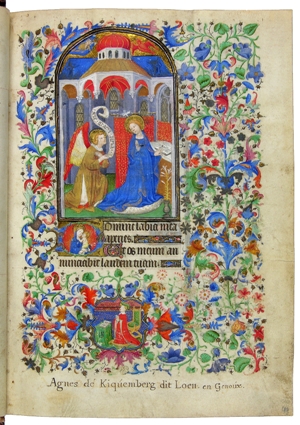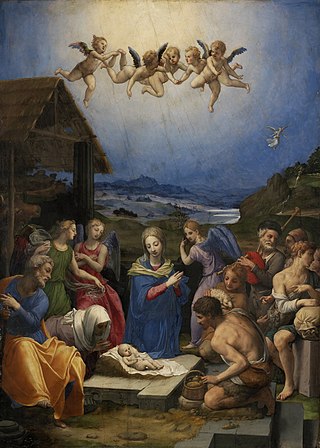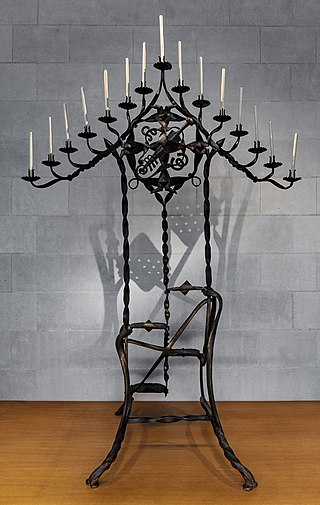Related Research Articles

An antiphon is a short chant in Christian ritual, sung as a refrain. The texts of antiphons are the Psalms. Their form was favored by St Ambrose and they feature prominently in Ambrosian chant, but they are used widely in Gregorian chant as well. They may be used during Mass, for the Introit, the Offertory or the Communion. They may also be used in the Liturgy of the Hours, typically for Lauds or Vespers.

Vespers is a liturgy of evening prayer, one of the canonical hours in Catholic, Eastern Orthodox, Oriental Orthodox, and Lutheran liturgies. The word for this fixed prayer time comes from the Latin vesper, meaning "evening".

In the practice of Christianity, canonical hours mark the divisions of the day in terms of fixed times of prayer at regular intervals. A book of hours, chiefly a breviary, normally contains a version of, or selection from, such prayers.
A carol is a festive song, generally religious but not necessarily connected with Christian church worship, and sometimes accompanied by a dance. A caroller is someone who sings carols, and is said to be carolling.

"Gloria in excelsis Deo" is a Christian hymn known also as the Greater Doxology and the Angelic Hymn/Hymn of the Angels. The name is often abbreviated to Gloria in Excelsis or simply Gloria.

Anglican church music is music that is written for Christian worship in Anglican religious services, forming part of the liturgy. It mostly consists of pieces written to be sung by a church choir, which may sing a cappella or accompanied by an organ.

"Hark! The Herald Angels Sing" is an English Christmas carol that first appeared in 1739 in the collection Hymns and Sacred Poems. The carol, based on Luke 2:14, tells of an angelic chorus singing praises to God. As it is known in the modern era, it features lyrical contributions from Charles Wesley and George Whitefield, two of the founding ministers of Methodism, with music adapted from "Vaterland, in deinen Gauen" from Felix Mendelssohn's cantata Festgesang.

Lauds is a canonical hour of the Divine office. In the Roman Rite Liturgy of the Hours it is one of the major hours, usually held after Matins, in the early morning hours.

Tenebrae is a religious service of Western Christianity held during the three days preceding Easter Day, and characterized by gradual extinguishing of candles, and by a "strepitus" or "loud noise" taking place in total darkness near the end of the service.

Church music is Christian music written for performance in church, or any musical setting of ecclesiastical liturgy, or music set to words expressing propositions of a sacred nature, such as a hymn.

Marian hymns are Christian songs focused on Mary, mother of Jesus. They are used in both devotional and liturgical services, particularly by the Roman Catholic, Eastern Orthodox, Oriental Orthodox, Anglican, and Lutheran churches. They are often used in the month of May devotions. Some have also been adopted as Christmas hymns. Marian hymns are not popular among some Protestants, as they see Marian veneration as idolatry. However, the practice is very common among Christians of Catholic traditions, and a key component of the Eastern Orthodox liturgy. There are many more hymns to Mary within the Eastern Orthodox yearly cycle of liturgy than in Roman Catholic liturgy.

The Liturgy of the Hours or Divine Office or Opus Dei are a set of Catholic prayers comprising the canonical hours, often also referred to as the breviary, of the Latin Church. The Liturgy of the Hours forms the official set of prayers "marking the hours of each day and sanctifying the day with prayer." The term "Liturgy of the Hours" has been retroactively applied to the practices of saying the canonical hours in both the Christian East and West–particularly within the Latin liturgical rites–prior to the Second Vatican Council, and is the official term for the canonical hours promulgated for usage by the Latin Church in 1971. Before 1971, the official form for the Latin Church was the Breviarium Romanum, first published in 1568 with major editions through 1962.
The ordinary, in Catholic liturgies, refers to the part of the Mass or of the canonical hours that is reasonably constant without regard to the date on which the service is performed. It is contrasted to the proper, which is that part of these liturgies that varies according to the date, either representing an observance within the liturgical year, or of a particular saint or significant event, or to the common which contains those parts that are common to an entire category of saints such as apostles or martyrs.
A sequence is a chant or hymn sung or recited during the liturgical celebration of the Eucharist for many Christian denominations, before the proclamation of the Gospel. By the time of the Council of Trent (1543–1563) there were sequences for many feasts in the Church's year.
Vespers is the evening prayer service in the liturgies of the canonical hours. The word comes from the Greek εσπερινός and its Latin equivalent vesper, meaning "evening." In Lutheranism the traditional form has varied widely with time and place. Martin Luther, in his German Mass and Order of Divine Service (1526') recommended reading the gospel in Latin in schools: "Then let another boy read the same chapter in German for practice, and in case any layman were there to hear...In the same way at Vespers, let them sing the Vesper Psalms as sung hitherto, in Latin, with an antiphon; then a hymn, as there is opportunity." While Latin vespers continued to be said in large churches, many experiments with simplified liturgies were made, including combining the hours of vespers and compline, later taken up in Thomas Cranmer's Anglican evensong. Under the influence of the 20th century Liturgical movement the Alpirsbach circle reintroduced Gregorian chant and spawned the Evangelisch-Lutherische Gebetsbruderschaft, established in 1954, which publishes the Breviarium Lipsiensae or Leipzig Breviary.

"Rorate caeli" or "Rorate coeli" are the opening words of Isaiah 45:8 in the Vulgate. The text appears at several points in the Christian liturgy during Advent.
Advent songs are songs and hymns intended for Advent, the four weeks of preparation for Christmas. Topics of the time of expectation are the hope for a Messiah, prophecies, and the symbolism of light, among others. Several of the songs are part of hymnals such as the German Catholic Gotteslob (GL) and the Protestant Evangelisches Gesangbuch (EG).
George Herbert Palmer was an English Anglo-Catholic priest, musicologist, organist, and expert on plainchant, particularly of the Sarum Use. Named after the priest and poet George Herbert, he was ordained a priest in Chester in 1871 and later was organist of St Margaret's Church in Toxteth Park, Liverpool, and St Barnabas, Pimlico, London. He helped found the Plainsong and Medieval Music Society (PMMS) in 1888. The majority of his extensive editions of liturgical music and texts were produced by the PMMS and the Community of St Mary the Virgin at Wantage in Oxfordshire. He was notable and influential for his musically sensitive translations of Latin hymns into English.
References
- ↑ "En clara vox redarguit". Rome of the West. Retrieved 9 November 2018.
- ↑ "Vox clara ecce intonat". Preces Latinae. Retrieved 9 November 2018.
- ↑ "Vox Clara Ecce Intonat: Newman's 'Hark! a gladsome voice is thrilling'". A clerk of Oxford. Retrieved 9 November 2018.
- ↑ "Vox clara ecce intonat". The Canterbury Dictionary of Hymnology. Retrieved 9 November 2018.
- ↑ Adey, Lionel (August 1986). Chapter 6. ISBN 9780774802574 . Retrieved 9 November 2018.
{{cite book}}:|website=ignored (help) - ↑ "En vox clara redarguit". Encyclopedia.Com. Retrieved 9 November 2018.
- ↑ "The Advent Office". Chant Blog. Retrieved 9 November 2018.
- ↑ "En clara vox redarguit". Hymns and Carols of Christmas. Retrieved 9 November 2018.
- ↑ "En clara vox redarguit". Hymns and Carols of Christmas. Retrieved 9 November 2018.
- ↑ "The Advent Office". Chant Blog. Retrieved 9 November 2018.
- ↑ "Hark! A herald voice is calling". Hymnary.Org. Retrieved 9 November 2018.
- ↑ See "Together in Song: Australina Hymn Book II" (Harper Collinss Religious: 1999) or "Lutheran Hymnal" (Lutheran Publishing House: 1973)
